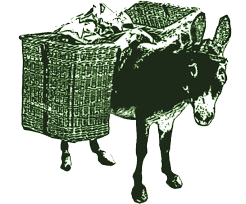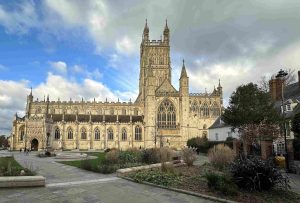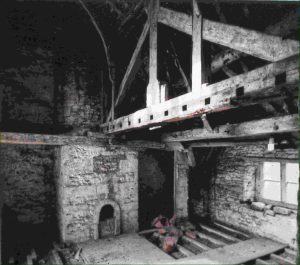Wednesday 17 April – Slides from the Michael Mills Collection and Beyond
Standing room only for our annual slide show, which this year also featured photos sent to us by others or from later collections as well as from the original Michael Mills collection. An eclectic selection presented by Camilla Boon, Roger Carnt and Heather Collins, ranging from general and aerial views of the villages, through schools, railways, snow and floods to village events from plays to the Ashmeads fair. We hope there was something for everyone and that those who recognised themselves or their relatives in a picture enjoyed the experience!
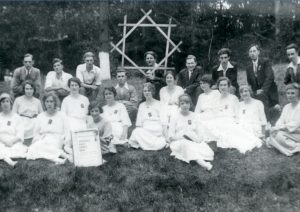
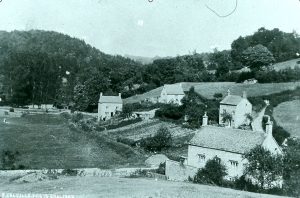
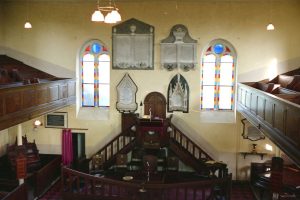
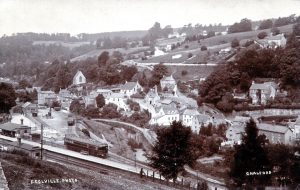
Wednesday 20 March – Gloucester Cathedral, a Royal Abbey
John Dawson, who is an official Cathedral guide gave a fascinating and informative talk on “Gloucester Cathedral, a Royal Abbey” at our March meeting. John started by noting that you can see the Cathedral everywhere you go in Gloucester and its iconic tower is visible for miles on every approach to the city.
The first Abbey was built on a neighbouring site inside the Roman Walls in the seventh century by King Osric, whose statue is in the South porch. The first Abbess, Kyneburga is also commemorated in the south aisle with a modern statue, which is carrying a bronze crook manufactured by Pangolin Editions of Chalford.
It was William the Conqueror who built a new Abbey in the location of the present building. Following the traditions of his Saxon predecessors he held three Witans or Courts at London, Winchester and Gloucester and as only Gloucester lacked a grand Abbey, he decided to have one built. The Chapter House was built first and within its walls William gave the order for the Domesday Book to be prepared. The foundation stone of what became St Peter’s Abbey and is now Gloucester Cathedral was laid in 1089 and much of the original structure is still visible today, in particular the crypt, the east end and the great pillars of the nave which still show the traces of discolouration from a fire in the twelfth century.
The location of the new cathedral caused problems almost at once as it had been inadvertently built over the filled-in ditch from the Roman walls. The building was plagued with issues in its first hundred years, the wooden vault caught fire, the walls over the old ditch started to collapse, the south tower fell down and the main tower burned down, was rebuilt with a spire and then that fell down. Eventually, early rebuilding in stone, the addition of supporting buttresses and the remodelling of the west end resulted in largely the same floor plan that we still see today. The current tower was modelled on the one at Chipping Camden and contains the bell Great Peter which at just under three tonnes is the largest medieval bell in Britain.
Gloucester has a number of Royal connections. Robert, Duke of Normandy, eldest son of the Conqueror who was dispossessed and imprisoned by his brother Henry I is buried here. Henry III the son of King John was hurriedly crowned here as it was the nearest suitable building after the death of his father. Edward II, who was imprisoned and foully murdered in Berkeley Castle is buried here in an ornate tomb raised by his son Edward III who also had extensive rebuilding in the new Gothic Perpendicular style carried out in his father’s memory.
The magnificent Lady Chapel was added in 1450 and the cloisters – made famous worldwide as part of Hogwarts for the Harry Potter films – were also finished in the 1400s. Henry VIII came to Gloucester on a royal progress in 1535 and visited the Abbey, which was consequently spared from the worst excesses of Thomas Cromwell’s reformers a few years later.
Since the Reformation Gloucester Cathedral has continued to play a rich part in the history of the area and the country. During the Civil War, Parliamentarian troops used the tower as a lookout point during the siege of Gloucester. Edward Jenner who was born in Berkeley and is regarded as the inventor of modern vaccination is commemorated with a statue in the nave. The Victorians carried out extensive renovations, especially within the Quire. In WW2 the Coronation chair was brought here from London and safely stored in the crypt. In 2015 Gloucester became the first Church of England Diocese to have a female Bishop.
Space does not allow us to recount all the amazing detail that John presented on the evening, so we highly recommend that if you are in Gloucester, you visit for yourself and maybe take a guided tour.
Links for further information
More on the heritage and architecture of the Cathedral
Wednesday 21 February – Industrial Heritage of the Forest of Dean
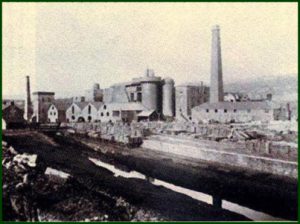
Dr Ray Wilson, a retired nuclear physicist who was the Secretary of the Gloucestershire Society of Industrial Archaeology for over 40 years gave a fascinating and informative talk at our February meeting on the industrial heritage of the Forest of Dean.
Ray began by briefly introducing us to the geography, geology and history of the Forest of Dean, a Royal hunting forest since Saxon times, which is now partly in public ownership and partly owned by the Crown. He also discussed some of the ancient traditions and offices such as the Verderers’ Court at Speech House and the right of those born in the “Hundred of St Briavels” to act as Free Miners which still exist today.
Iron, coal and stone are thought to have been mined or quarried in the Forest since Roman times. In their heyday these industries employed thousands and some of the sites, such as Cinderford Ironworks (developed by the South Wales Crawshay iron masters) and Foxes Bridge Colliery just outside Cinderford were surprisingly extensive.
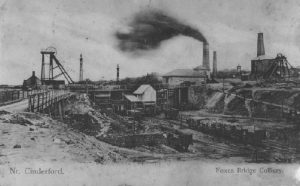
Through a series of his photos, Ray showed us how glimpses of the Forest’s industrial heritage can be seen all around the area if you know what to look for. Examples include vertical mine shafts or horizonal adits dug by miners into the hillside, ventilation chimneys for underground mines, furnace buildings, former stone quarries, remains of tramway or railway lines used for transporting the heavy product, tunnels, bridges, and viaducts.
Signs are also visible in non-industrial buildings which have often survived the demolition of the Works they once supported, such as Managers’ houses or industrial housing for workers (unusual in Gloucestershire), and also in Newland Church, dubbed “The Cathedral of the Forest”, which houses the famous Freeminer brass.
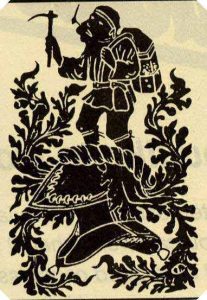
By Dooshy68 – Own work, CC BY-SA 3.0, Creative Copyright Link
Among the more important sites mentioned by Ray during the talk and well worth a visit are the following:
Dark Hill Iron Works. Developed by the Mushet family, father and son David and Robert, where they carried out secret experiments to improve the steel-making process. Robert discovered the secret to improving the existing Bessemer steel process, which was subsequently exploited commercially by Henry Bessemer, who eventually agreed to pay him a pension of £300 per year rather than see him living in poverty. Today only low walls and the outlines of tramways and roadways from the works are left on this site and the neighbouring Titanic steelworks.
Bixhead stone quarry and Bickslade tramway. There is still one working quarry here, but there are also extensive abandoned quarry workings and some lovely walks up the old tramways. These were originally horse-drawn tramways, but most were eventually developed into narrow gauge railways. Ray also described how the railways developed across the Forest as a transport network to take the coal to the ironworks and further afield to the River Severn for onward transport by boat.
Lydney Harbour. Coal from the Forest was brought here by railway and loaded onto small boats. Although partly fenced off at the moment for safety reasons the harbour and walk along the adjacent foreshore still shows signs of the former activity, with some remains of old boats visible at low tide. The building of the Severn railway bridge allowing the coal to be taken in wagons direct to Sharpness effectively signalled the end of Lydney as a coal port. Ray also described the Severn Bridge disaster of 1960 when two barges collided with one another and then with the bridge, bringing down two full spans and killing some of the boats’ crews. Today little is left of the bridge, though the tower of the swing section over the canal still remains.
Whitecliff iron furnace. This relatively well-preserved building used for smelting iron using coke as a fuel was in fact not a very successful site, which is why it probably survives today instead of having been rebuilt successively as some of the other sites have been.
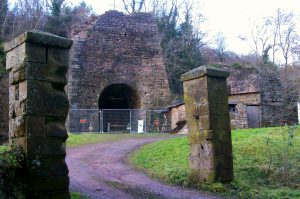
by Obscurasky – Own work, CC BY-SA 3.0, Creative Copyright link
Gunn’s Mill Furnace. Originally a 17th century blast furnace powered by charcoal and then a paper mill it has fallen into a very poor condition. The Forest of Dean Buildings Preservation Trust have recently been granted money by Historic England to allow for restoration and preservation.
Ray also briefly mentioned other local industries such as brick making and printing, which had grown up to support the main Forest industries and concluded with a mention of the Dean Heritage Centre in a former mill which today is a museum with extensive displays.
Links for those interested in further reading on the Forest of Dean and on industrial archaeology in Gloucestershire.
Gloucestershire Society for Industrial Archaeology https://gsia.org.uk/
Dean Heritage Centre https://www.deanheritagecentre.com/
David and Robert Mushet https://www.visitdeanwye.co.uk/explore/famous-people/david-and-robert-mushet
The “Cathedral of the Forest” https://www.allsaintsnewland.com/
Gunns Mill preservation project https://www.fodbpt.org/gunns-mill
Whitecliff ironworks https://www.visitdeanwye.co.uk/things-to-do/whitecliff-ironworks-p1356061
Free miners in the Forest https://www.forestfreeminers.org/
Wednesday 17 January 2024
John Peters gave a fascinating and varied talk describing his experiences as a volunteer photographer for English Heritage (now Historic England), helping to compile the photographs of buildings used on their Listed Building website. Having started the project in 1999, Historic England had to appeal to volunteers to help them complete it. John was provided with a list of “targets”, many of which were not whole buildings at all but included structures such as gate posts, bridges and churchyard monuments.
John described for us many of his favourite assignments including Daglingworth Church, which dates from Saxon times, and the “step pyramid graves” in St Laurence Churchyard Stroud and urged us to go and see both of these if we had not already done so.
He also entertained us with stories of some of his more difficult assignments including houses where the owners refused him access, the building that was almost imposisble to photograph as it was in such a narrow street and the various “technically illegal” photos he was asked to take of jails and schools.
